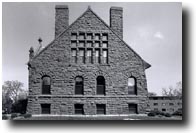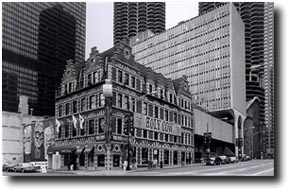 |
Lewis has no wish to raise Cobb to genius status. But he would
like more people to know about the man he describes as one of the
leaders of the Chicago school, “a group of Midwestern architects
who made great developments in structure and design.” And he
has been given the opportunity to do just that. Last year, some
40 years after he wrote his master’s thesis on Cobb’s
campus oeuvre, Lewis was commissioned by the Richard H. Driehaus
Foundation to produce a book on Cobb’s other buildings.
|

While the top floor of the Durand
Institute at Lake Forest College, according to Lewis, “has
obviously been much mauled,” the wood and the grand space
remain “Cobb at his best.” Lewis also notes similarities
to the architect’s work at the Yerkes Observatory, including
the way that Cobb used wood to emphasize the strong, graceful
lines of the room’s high-pitched ceiling.
|
Driehaus, the CEO of Driehaus Capital Management, Inc., first
became interested in Cobb when he bought the Cable House, a down-at-the-heels
mansion at 25 East Erie Street, built by Cobb and Frost in 1886
for Ransom R. Cable, the president of the Chicago, Rock Island and
Pacific Railway Company. While changing the building’s interior
to accommodate a contemporary lifestyle, Driehaus carefully restored
the exterior to its original grandeur. He asked the foundation’s
executive director, Sonia K. (“Sunny”) Fischer, AM’82,
to see if she could find more information on Cobb. Tracking down
Lewis’s thesis, Fischer called to ask him for a copy.
|

Not all of Cobb’s work was
completely successful, as this side view of the Durand Institute
demonstrates. Though the rectangular brace of windows provides
wonderful illumination of the interior space, it’s out
of scale with the two sets of windows below. “It would
be very beautiful if you could ignore the bottom two floors,”
laments Lewis. “Richardson would have done better.”
|
The attorney readily assented—on the condition that he be
given an insider’s tour of the restored Cable House. When Lewis
met Driehaus, the proud owner asked if he knew anyone who could
write a book on Cobb. The reply came quickly: If anyone did such
a book, “it ought to be me.”
Driehaus agreed, supplying funds to have Hyde Park photographer
Patricia Evans provide visual documentation of Cobb’s buildings
and to hire Lewis a research assistant—Ronn M. Daniel, an Illinois
Institute of Technology–trained architect and a U of C graduate
student in the history of culture. Soon after, Lewis and Daniel
began to track down material, visiting buildings in and around Chicago.
With 85 percent of the research complete, this summer Lewis was
about to embark on the book’s first draft. He hopes the project—which
incorporates his thesis but includes a great deal of new material—will
be done within a year.
Gathering information on Cobb and his non–U of C buildings
hasn’t been easy. “His papers are all gone,” Lewis
notes, and so the task has been one of reconstruction.
|

Like the current occupant of the
building at the southeast corner of North Dearborn and West
Kinzie Streets—Harry Caray’s Restaurant—Cobb’s
original client, a fuel oil and paint company, wanted a structure
that stood out. Cobb achieved that, using decorative details
from the Dutch Renaissance (patterned brick and stone and
stepped gables) for the warehouse cum office building.
|
Although it’s been especially hard to trace Cobb’s work
after he ended his connection with the University, accounts of Cobb’s
early years aren’t much more detailed. Born in Massachusetts
in 1859, he was one of the earliest students to complete an architecture
course—the nation’s first such formal course—offered
by the Massachusetts Institute of Technology. A few months after
his 1880 graduation, he made the obligatory trip to Europe to see
the great buildings he had studied. Upon his return, he worked for
a few months at the Boston firm of Peabody and Stearns before heading
west in 1881 to Chicago, where he soon flourished.
Continued...
|



